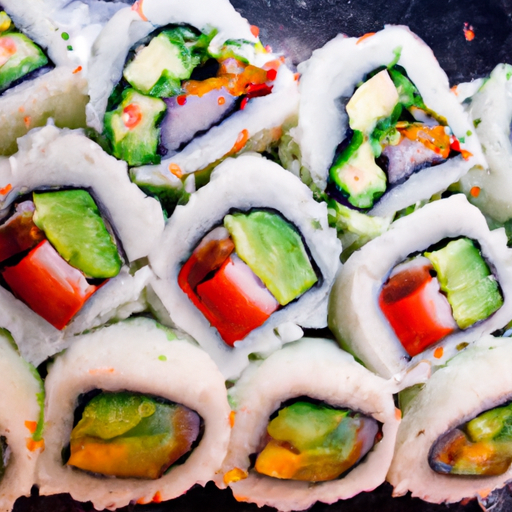Have you ever wondered how a simple dish from Japan managed to take the world by storm? Prepare to be amazed as we take you on a journey through the captivating story of how sushi conquered the globe. Join us as we explore the fascinating origins of this culinary sensation, its evolution over the centuries, and the key factors that propelled sushi into becoming a beloved international delicacy. Brace yourself for a mouthwatering adventure that will leave you with a newfound appreciation for the power of food to unite cultures and transcend borders.

The Origins of Sushi
Sushi, a beloved and iconic dish of Japanese cuisine, has a rich and fascinating history that stretches back centuries. The origins of sushi can be traced back to Japan, where it first emerged as a simple method of preserving fish. In ancient times, fish would be salted and fermented, then wrapped in rice as a means of preservation. This process allowed the fish to be stored for extended periods of time, especially during the winter months when fresh fish was scarce.
The Beginnings of Sushi in Japan
During the Muromachi period (1336-1573), sushi began to evolve from a preservation method to a delicacy. The process of fermenting the fish was gradually replaced with a method known as narezushi, where fish was marinated in rice vinegar to give it a tangy flavor. This new method allowed the fish to be eaten after a shorter fermentation period, making it more accessible and appetizing.
The Evolution of Sushi
As time went on, sushi continued to evolve and gain popularity. In the 19th century, a new style of sushi called nigiri sushi emerged. Nigiri sushi consists of a small mound of rice topped with a slice of raw fish. This style of sushi allowed the flavors of the fish to shine through, and it quickly became a favorite among sushi lovers.
Sushi as a Staple in Japanese Cuisine
Today, sushi is deeply ingrained in Japanese culture and cuisine. It is commonly enjoyed as a special treat or as part of celebratory occasions. From traditional sushiya (sushi restaurants) to conveyor belt sushi joints, sushi has become a staple in the daily lives of the Japanese people. It is a testament to the culinary tradition and craftsmanship that has been passed down through generations.
The Introduction of Sushi to the Western World
The first sushi restaurants in the Western world began to appear in the mid-20th century, primarily in major cities with a significant Japanese immigrant population. These early sushi establishments catered mainly to the Japanese community, offering a taste of home away from home.
Sushi’s Initial Reception in Western Countries
At first, sushi faced a mixed reception in Western countries. Many Westerners were unfamiliar with raw fish and the idea of eating sushi was met with skepticism. However, adventurous food enthusiasts and cultural explorers began to embrace sushi, slowly introducing it to a wider audience.
Popularity and Spread of Sushi in the Western World
Over time, sushi gained popularity and started to appear on more diverse menus, from high-end dining establishments to fast-food chains. The rise of globalization and cultural exchange further contributed to the spread of sushi’s popularity. Today, sushi can be found in almost every major city around the world, from New York to Paris to Sydney.
Sushi’s Transformation into a Global Phenomenon
As sushi made its way around the world, it began to adapt to local tastes and preferences. In different countries, sushi variations and fusion creations emerged to cater to different palates. Sushi became a canvas for culinary experimentation, combining traditional Japanese flavors with local ingredients and techniques.
Influence of Sushi on Other Cuisines
Sushi’s global popularity also had a significant impact on other cuisines. Chefs and home cooks from various culinary backgrounds started to incorporate elements of sushi into their own dishes. Sushi-inspired rolls, known as “California rolls,” became widely popular in Western countries, blending Japanese ingredients with avocado and other local flavors.
Sushi’s Relationship with Health and Wellness
Sushi’s reputation as a healthy choice in the culinary world cannot be overstated. With its emphasis on fresh fish, seaweed, and vegetables, sushi is considered a nutritious and balanced meal option. The omega-3 fatty acids found in fish have been linked to numerous health benefits, including heart health and brain function.
The Role of Technology in the Sushi Industry
Technology has played a significant role in shaping the sushi industry, particularly in terms of automation and efficiency in sushi production. With the introduction of sushi-making machines, the process of forming sushi rolls became faster and more consistent. These machines allow sushi chefs to increase their production capacity while maintaining quality and precision.

Online Ordering and Delivery Services
In recent years, the rise of online ordering and food delivery services has also impacted the sushi industry. Customers can now conveniently order sushi from their favorite restaurants and have it delivered to their doorstep. This trend has made sushi more accessible to people who may not have easy access to a sushi restaurant.
Innovations in Sushi-making Equipment
Advancements in sushi-making equipment have also allowed for greater creativity and experimentation in the world of sushi. From sushi robots that can create intricate sushi designs to specialized knives and tools designed for precision slicing, these innovations have made sushi preparation more efficient and visually stunning.
Sushi’s Influence on Popular Culture
Sushi has left a lasting imprint on popular culture, making appearances in film, television, art, and fashion. In the world of cinema, sushi has been featured in various films, often depicted as a symbol of sophistication and luxury. In art and fashion, sushi has been celebrated for its vibrant colors and visually appealing presentation.
Sushi in Film and Television
From the iconic sushi scene in the film “Lost in Translation” to the sushi-centric plotline in the animated film “Jiro Dreams of Sushi,” sushi has become a recurring motif in movies and television shows. Its elegant and visually pleasing presentation makes for compelling visual storytelling.
Sushi as Art and Fashion
Sushi has also inspired artists and fashion designers, who have incorporated sushi motifs into their work. From sushi-themed paintings to sushi-shaped accessories, sushi has become a source of inspiration for creative expression.
Sushi’s Impact on Social Media
With the advent of social media, sushi has found a new platform for exposure and appreciation. Instagram and other image-based platforms have allowed sushi enthusiasts to showcase their favorite creations, inspiring others to try new sushi combinations and designs. Sushi’s visually appealing nature makes it a perfect subject for shareable content.
Challenges and Controversies in the Sushi World
While sushi has experienced widespread popularity, it has not been without its share of challenges and controversies. Several issues have arisen that have prompted debates and discussions within the sushi community and beyond.
Sustainability and Overfishing Issues
The growing demand for sushi has put significant pressure on seafood resources, leading to concerns about sustainability and overfishing. As certain fish populations decline, the sushi industry has been forced to adapt and promote sustainable fishing practices.
Debates over Authenticity and Cultural Appropriation
As sushi spread across the globe, debates have emerged regarding authenticity and cultural appropriation. Some argue that sushi should strictly adhere to traditional Japanese methods, while others believe that fusion and experimentation are essential for the evolution of cuisine.
Health Concerns with Raw Fish Consumption
Another area of concern is the potential health risks associated with consuming raw fish. Raw fish can contain parasites and bacteria, which can pose health hazards if not handled and prepared properly. The sushi industry has implemented strict regulations and food safety practices to ensure consumer safety.
The Globalization of Sushi
Sushi’s globalization has resulted in its presence in diverse countries and the development of regional variations.

Sushi’s Presence in Different Countries
Sushi is no longer limited to Japan or even Western countries. It has made its way into various cultures and cuisines, with sushi restaurants thriving in countries such as Brazil, Russia, and the Middle East.
Regional Variations of Sushi
Each country and region has put its unique spin on sushi, incorporating local ingredients and flavors. In the United States, for example, sushi rolls have become bigger and more extravagant, often featuring ingredients such as cream cheese and spicy sauces.
Sushi’s Cultural Significance in Various Societies
Sushi has become more than just a culinary delight; it has become a symbol of cultural exchange and globalization. It represents the fusion of different culinary traditions and demonstrates the power of food to transcend borders and bring people together.
The Economic Impact of Sushi
Sushi’s global popularity has had a profound economic impact, particularly in the seafood industry.
Sushi’s Contribution to the Seafood Industry
The rise in demand for sushi has created a significant market for seafood suppliers, fishermen, and aquaculture farms. This demand has led to job creation and economic growth in areas where seafood production is a vital industry.
Job Creation in the Sushi Market
The proliferation of sushi restaurants around the world has created numerous job opportunities for chefs, servers, and other hospitality professionals. Sushi’s popularity has also given rise to specialized roles, such as sushi chefs known as itamae, who are highly skilled in the art of sushi preparation.
Sushi’s Influence on Tourism
The allure of sushi, combined with its global presence, has turned it into a tourist attraction in its own right. Travelers often seek out renowned sushi restaurants and culinary experiences while visiting different countries, contributing to the growth of the tourism industry.
Sushi Beyond Traditional Boundaries
Sushi’s versatility has enabled it to transcend traditional boundaries and adapt to diverse dietary preferences and restrictions.
Sushi Fusion and Creative Variations
From sushi burritos to sushi tacos, sushi fusion has become a popular trend. Chefs and home cooks have embraced this creative approach, combining elements from various cuisines to create new and exciting sushi creations.
Vegan and Vegetarian Sushi
For those who follow a vegan or vegetarian diet, sushi has also undergone a transformation. Plant-based alternatives, such as sushi rolls made with tofu, avocado, and vegetables, have become more prevalent, catering to a wider range of dietary choices.
Sushi’s Inclusion in Non-Japanese Menus
Sushi’s popularity has led to its inclusion in menus that may not traditionally feature Japanese cuisine. From sushi-inspired burgers to sushi pizzas, non-Japanese restaurants have embraced sushi as a way to diversify their offerings and cater to evolving consumer preferences.
The Future of Sushi
As sushi continues to conquer the world, there are several trends and advancements that can be expected in the future.
Emerging Trends in Sushi Consumption
Diners can expect to see more experimentation and creativity in the world of sushi as chefs continue to push the boundaries of flavor combinations and presentation.
Advancements in Sustainable Sushi Practices
With a growing emphasis on sustainability and responsible sourcing, the sushi industry will likely see advancements in sustainable fishing practices and the development of alternative seafood options.
The Continued Global Expansion of Sushi
As more people around the world are exposed to sushi and develop a taste for this beloved dish, its global expansion is expected to continue. Sushi’s ability to adapt and incorporate diverse flavors makes it a timeless and ever-evolving culinary phenomenon.
In conclusion, sushi’s journey from a humble preservation method to a global culinary phenomenon is a testament to the power of food to transcend cultural boundaries and create connections. From its origins in Japan to its widespread popularity in the Western world and beyond, sushi has become a symbol of cultural exchange and culinary creativity. As sushi continues to conquer new territories, its future looks promising, with innovations in sustainable practices and a growing appetite for culinary experimentation. So the next time you enjoy a piece of sushi, remember the centuries of tradition and craftsmanship that went into creating this beloved dish.

